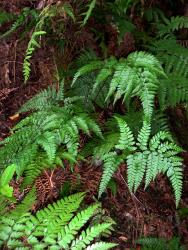- = Polystichopsis (J.Sm.) Holttum, J. Linn. Soc., Bot. 53: 149 (1947)
- = Byrsopteris C.V.Morton, Amer. Fern J. 50: 149 (1960)
Terrestrial ferns, evergreen. Rhizomes long-creeping, scaly. Rhizome scales non-clathrate, narrowly ovate to narrowly triangular, margins entire or toothed, attached at base, concolorous, pale brown or red-brown. Fronds monomorphic, not bulbiferous. Stipes and rachises scaly, adaxially sulcate. Laminae 3–4-pinnate (NZ), rarely 1–2- or 5-pinnnate (not NZ), coriaceous (NZ) or herbaceous (not NZ), scaly. Veins free. Sori round, borne on abaxial surface, away from the margin, in 1 row either side of midrib; indusia reniform, peltate. Spores monolete; perispores rugose or tuberculate, often minutely echinate on the surface.
A genus of over 80 species, included in the subfamily Dryopteridoideae (Lu et al. 2019).
Arachniodes is sister to Dryopteris, with these two genera in turn sister to the polystichoid ferns (Liu et al. 2016; Lu et al. 2019).
Only one species, Arachniodes aristata, occurs in New Zealand, where it is confined to the Kermadec Islands. It was treated as Rumohra aristata by Allan (1961).
In New Zealand the sole species of Arachniodes is confined to the Kermadec Islands. It is recognised by its terrestrial habit, long-creeping rhizomes, 3–4-pinnate laminae, scaly fronds, and round sori protected by reniform indusia. The spores are rugose with minute papillae on the surface (Large & Braggins 1991).
Arachniodes is a genus of tropical and temperate regions. The greatest diversity is in China and the Himalayas, with a few species extending to Africa, tropical America, Australia and the Pacific (Tindale 1961); 40 species in China (He et al. 2013), two in Africa and Madagascar (Roux 2009), and one widespread species in Australia and the Pacific (Jones 1998; Nakamura 2008). One non-endemic species in New Zealand.
| Category | Number |
|---|---|
| Indigenous (Non-endemic) | 1 |
| Total | 1 |
The base chromosome number in Arachniodes is x = 41 (Kramer 1990).




